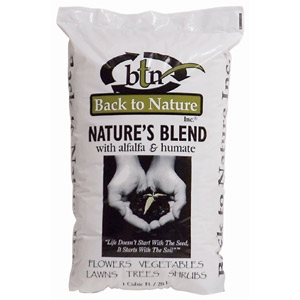After all the spring rains giving us lush green lawns, it sure didn’t take long for the dog days of summer to take its toll on some. We are diagnosing lots of chinch bugs and grub worm damage. James has a couple of videos on our website and You Tube about lawns. Be sure to check those out to help you diagnose your problems. You can also bring in a sample for us to look at. Use a shovel and dig us up a shovel width square of grass with the soil attached. You will be able to take the sample back home and put it back in the hole you dug. We will help diagnose your problem and get you the best solution to fix it. Spreading Natures Blend Compost over the area will help it to recover quicker. Continue with your once a week slow and deep watering through September and October, but after that, we should be able to cut back to every other week due to shorter days and cooler temperatures and hopefully more rainfall.
grass
October is the month to do your fall lawn fertilizing and weed prevention. After that it is getting late to have maximum effect. If weeds are a problem every winter and spring, use a pre-emergent to prevent the weeds from sprouting. Amaze granules or Weed and Grass Stopper with Dimension are the best to use in October to prevent winter weeds and again in January to prevent spring weeds. An organic alternative is Corn Gluten. These chemicals only last one season, so be sure to re-apply in 3 months. If you have any other questions on Lawn care for the fall and winter, come see me at the Airline Store on Saturday October 10th from 10:00-11:00, for our fall Garden Talk.
 -DeAnna
-DeAnna
 This time of year your lawn might not be looking so great. It might be patchy, or pale yellow, or just unhappy. Since St. Augustine grass goes dormant in the winter, fertilizer might not be the best choice. Instead try using Nature’s Blend compost. It’s an alfalfa humate blend that helps your lawn against fungus and feeds the roots. One bag covers 50 square feet of a healthy lawn, or if it’s struggling use one bag per 25sqft. Make sure you spread it to 1/2” or less! Nature’s Blend provides protection against temperature and moisture extremes too, so your lawn has the best chance of surviving the winter and emerging in spring.
This time of year your lawn might not be looking so great. It might be patchy, or pale yellow, or just unhappy. Since St. Augustine grass goes dormant in the winter, fertilizer might not be the best choice. Instead try using Nature’s Blend compost. It’s an alfalfa humate blend that helps your lawn against fungus and feeds the roots. One bag covers 50 square feet of a healthy lawn, or if it’s struggling use one bag per 25sqft. Make sure you spread it to 1/2” or less! Nature’s Blend provides protection against temperature and moisture extremes too, so your lawn has the best chance of surviving the winter and emerging in spring.
 -Marta
-Marta
Pre Spring tips…do now & save time later!
Do
- Apply Pre-emergents Amaze or Hi Yield Weed and Grass Preventor with Dimension to prevent spring weeds.
- Spray All Seasons Oil to kill and prevent scale insects this spring on flax lily, cast iron plant, irises, pittosporums & hollies.
- Treat for lawn fungus as a cure and preventative due to damp weather with F-Stop or Bayer Lawn Fungus Control, organically with Serenade or Natures Blend.
- Prepare veggie gardens for spring plantings. Pull up all old vegetables, and rework the soil with Cotton Burr Compost or Natures Blend.
Don’t
- Prune indian hawthorns, azaleas, or carolina jasmine since they are an early spring bloomer.
- Prune tropicals, ex. hibiscus, bougainvilleas, lantanas, plumbagos, etc..
- Spray a weed killer (it is too cold to be effective).
One day you look outside at your lawn and BAM, you notice there are weeds everywhere! Before you start spraying with an herbicide, make sure you read the label. Some weed killers have temperature restrictions and either take longer to work or don’t work at all! A better option for this time of year is to put down a pre-emergent weed prevention like Hi Yield Weed & Grass Stopper With Dimension or Fertilome Broadleaf Weed Control With Gallery to stop the spread of weeds until the weather warms up. It won’t kill the weeds you have now but it sure will slow the weed crop down in the months to come.
 –Marta
–Marta
Now is the time to kill any weeds that have popped up in the lawn. The weather needs to be warm and sunny for 3-5 days with no rain or water on the lawn for Weed B Gon to work the best. It comes with a hose-end applicator on the bottle and enough to spray over 2500 sq. ft of lawn area. Do not mow first, but do make sure the lawn is watered well before spraying. And yes, it is safe to use on Floratam St. Augustine. Give it a full 2 weeks to work its magic and by then the grass should be out of winter dormancy and it will be time to fertilize.

–DeAnna
1. Proper Watering
This is the most important of all. Water slow and deep to make sure at least one inch of water is applied to all established lawn and landscape plants for our long hot summers. Smaller bedding plants such as annual color and perennial beds will require a second supplemental watering since they have a smaller root system.
2. Mulching
Use hardwood mulch three to four inches deep in planting beds to help conserve moisture as well as control weeds. Most mulch is applied too thin, only two inches rather than three to four. Do not bury crown of plant or trunk of shrubs.
3. Top Dress The Lawn
A thin layer of Nature’s Blend Compost applied several times a year helps to enrich the soil and will cut watering demands.
4. Insect Controls
Many insects are seasonal. Chinch bugs attack lawns in the hot summer months, so watch the edges of your lawn for the first signs. Spider mites also love the hot dry summer season. Keep an eye on junipers, pittosporums and houseplants for signs of mottling on the leaves or leaf drop and treat as soon as possible. Mealy bugs are also a hot weather insect and leave white cotton along the stems and undersides of many plants. More than one application may be needed to control some of these insects.
5. Fungus Control
This is not always an issue in the summer, but can be if we are getting periods of heavy rain. Proper year round watering and adding Nature’s Blend several times a year will help minimize fungal issues.
6. Fertilizing
Keeping your plants fed for the summer is very important, but applying at a lower rate may help to keep them healthy without encouraging too much new growth. Using organic fertilizers keep the plants healthy which minimizes insect attacks, Milorganite Fertilizer for instance.
7. Pruning
Some plants will need to be pruned in the summer to keep them more compact and not overgrown. Be careful, though, since some plants can sunburn easily when removing the upper leaves which have been shading the rest of the plant.
8. Weed Control
Some weeds burn off in the summer heat. Pre-emergents, such as Green Light Amaze and Hi Yield Weed & Grass Stopper can be applied year round in landscape beds to prevent weeds. Organic weed killers, such as Nature’s Guide Horticultural Vinegar, for landscape beds, are most effective in hot summer temperatures. But broadleaf lawn weed killers cannot be used in your grass once temperatures get above 85 degrees due to burning. Keep the grass mowed to remove seed heads of weeds. Mechanical means is always the best.
9. Proper Mowing Height
Proper mowing height will shade the ground and cause less water evaporation from the soil, reducing water needs. St. Augustine is best at three inches, so raise the mower. Also a sharp mower blade helps the grass look fresh and green, while a dull blade leaves ragged edges that turn brown and cause the lawn to look somewhat dead and dull.
10. Proper Plant – Proper Place
With any landscape make sure you have thought out the full mature height and width of plants, sun requirements and water needs before planting. You should never be constantly pruning a plant because it is too large for the space. That is the wrong plant for the spot. Also group like water need plants together. The most drought tolerant plants should be those furthest from the water source.
Now that you have worked hard at planting and maintaining the landscape, take the time to kick back, relax and admire the beauty you created. Gardening is great therapy! it not only burns calories, it also reduces stress from a hard day’s work and helps to lower blood pressure. Colleges are even offering courses in horticultural therapy. Gardeners live longer lives; plants give you reason to get up and get moving!
 -DeAnna
-DeAnna
In the past week or two lawns all over town are looking like they are drying up from the heat of summer. Well, this could be true if you are not watering slow and deep enough. Make sure you are applying a least an inch of water when you do water. Use a cat food can or tuna fish can to measure. Set the can in the lawn, turn on the sprinkler and when the can is full to a 1″ mark, you have watered long enough. Since temperatures have soared to the upper 90’s , everything is super dry. Chinch bugs like it hot and dry so be sure and check for signs of them. The grass will look like you haven’t watered, but when you push a shovel into the lawn it goes in easy and you reach your finger in and feel moisture (If you can’t push a shovel in, see above). You can dig up a shovel width sample, (dirt and all) and turn it upside down over white paper and see if any chinch bugs fall out, or you can bring it to us and we will check. Using a liquid insecticide like Cyonara Hose-end or Triazicide Hose-end works well. You can use Spinosad or Diatomaceous Earth as an organic option. Once the Chinch bugs are dead the lawn will recover quickly. You may need to reapply in a few weeks since we have another month of hot weather ahead and chinch bugs love the heat. Another summer insect is grub worms. They begin feeding usually around June – July and by now the damage begins to show up. If the grass lifts up easily (no roots), and you dig down and find grubs ( more than 4 in one square foot) apply Bayer 24 hour Grub Worm Killer or Triazicide granules and water in thoroughly.
 -DeAnna
-DeAnna

